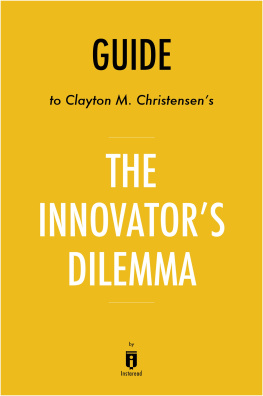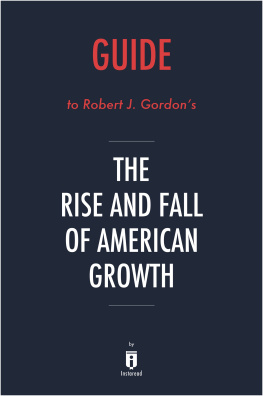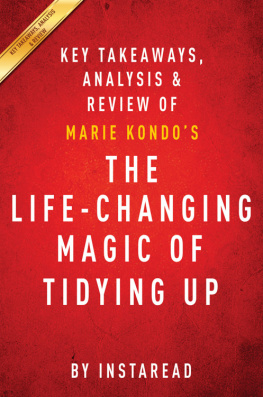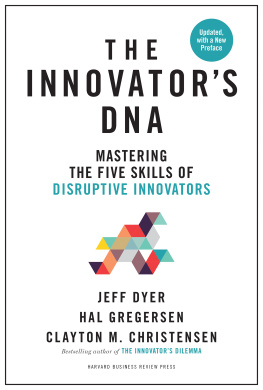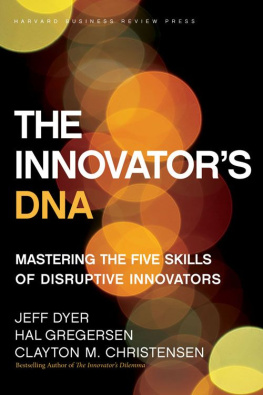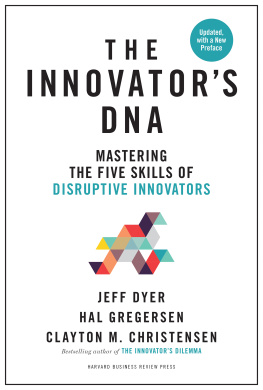Guide to
Clayton M. Christensens
The Innovators Dilemma
When New Technologies Cause Great Firms to Fail
by
Instaread
Please Note
This is a companion to the original book.
Copyright 2016 by Instaread. All rights reserved worldwide. No part of this publication may be reproduced or transmitted in any form without the prior written consent of the publisher.
Limit of Liability/Disclaimer of Warranty: The publisher and author make no representations or warranties with respect to the accuracy or completeness of these contents and disclaim all warranties such as warranties of fitness for a particular purpose. The author or publisher is not liable for any damages whatsoever. The fact that an individual or organization is referred to in this document as a citation or source of information does not imply that the author or publisher endorses the information that the individual or organization provided. This concise companion is unofficial and is not authorized, approved, licensed, or endorsed by the original books author or publisher.
Table of Contents
Overview
The Innovators Dilemma contemplates the difficulties of maintaining a firms position when faced with innovative technologies. It was first published in 1997 and remains an influential text for its descriptions of the reasons that some of the most successful firms in a given business often rapidly lose market share to new challengers.
Large companies that spend millions on research and development often fail to effectively confront challenges posed by innovation. Traditional business practices such as conducting strategic planning and paying close attention to customer needs are insufficient for negotiating disruptive innovations in the market. This is the innovators dilemma. Business managers must be prepared to confront this paradox. Rather than specific suggestions, they require a theoretical framework to manage the impact of disruptive innovation on established firms.
The history of the disk drive industry from the 1970s into the mid-1990s suggests that business innovations can come in two forms: innovations that help established firms maintain their advantages, and disruptive innovations that can rapidly transform an industry. Disruptive innovation is likely to come in the guise of a low-cost product that initially appeals only to a few consumers. The disruptive innovation gains customers in its market by providing a cheaper and more convenient alternative. Disruptive innovation is a relentless process, so established firms must be prepared to confront disruption when it occurs in their markets.
Important People
Clayton M. Christensen is a former business consultant and is professor of business administration at the Harvard Business School.
Key Insights
- Improvements to a new technology are easy at first but become more difficult to achieve over time.
- Technological innovations can be divided into two types: sustaining innovations and disruptive innovations.
- Disruptive innovations are often able to earn a place in the market by focusing on price point.
- Listening to customers and responding to their wishes can actually be counterproductive. Disruptive innovations create their own markets.
- While market research is a key part of product development in large firms, it is impossible to do market research with customers and clients of new technologies.
- Market dynamics can favor new entrants into a businesss sector at the expense of well-established firms.
- Large companies are bureaucratic. Innovation within them is often difficult as a result.
- Defectors who leave successful companies to start rival firms can be a serious challenge to the position of established firms in the market.
Analysis
Key Insight 1
Improvements to a new technology are easy at first but become more difficult to achieve over time.
Analysis
When a new technology is developed, the initial improvements to that technology come readily. Over time, new developments become more difficult for research efforts to achieve. An initial breakthrough, whether by luck or by research, leads to a products commercial viability. Customer feedback provides a guide, and small changes can be made in the design at little cost. This can lead to a steady rate of improvement for some technologies with new versions being released on a regular schedule. Thereafter, research leads to diminishing marginal returns. Improvements can be made, but they cost more time and effort to achieve. The slowing pace of innovation can inspire rival products.
The history of Velcro offers an example. Velcro was first patented in 1955. The Velcro company initially used cotton for its product before quickly discovering that nylon cloth improved the products performance. The next innovation in the products history was the use of colored Velcro in the late 1950s. Since these two early product innovations, new uses and developments have been rare, though the brief appeal of Velcro shoes in the 1980s and the Velcro Wall in the 1990s suggests innovations and market opportunities for the product do continue to occur. Instead, the
Velcro company has had to increasingly compete with similar lower-cost products from rival firms. [1]
Key Insight 2
Technological innovations can be divided into two types: sustaining innovations and disruptive innovations.
Analysis
Although all innovations cause some disruption, not all innovations are categorically disruptive. Some technological innovations sustain the role of incumbents in the market by helping established firms maintain their mainstream customers. Disruptive innovations weaken the hold of established firms; they are more likely to focus on developing fringe features that appeal to only a few customers.
A new innovation can be sustaining to one industry but disruptive to others. Electric cars are a potentially disruptive innovation for traditional automobile manufacturers and gas stations. They are also a sustaining innovation for the highway construction industry or the automobile insurance industry. When determining whether an innovation is sustaining or disruptive, it is better to judge its impact, rather than its design. No matter how revolutionary in design, a new product is not a disruptive innovation unless it potentially threatens the role of established players in a market.
Key Insight 3
Disruptive innovations are often able to earn a place in the market by focusing on price point.
Analysis
From the 1970s into the 1990s, the technical specifications of disk drives changed as the price per megabyte paid by consumers was driven lower in each new generation of technology. Throughout its history, innovation in the disk-drive industry largely consisted of repackaging existing technologies in new ways that led to steady reductions in prices per megabyte. The first external hard disk, completed in 1956, was bigger than a refrigerator. Despite its size, this device could only store five megabytes worth of data. [2] By 1980, five megabytes of data could be stored on a single 5.25-inch disk. [3] In the 1980s 3.5-inch super disks were released capable of storing 10 megabytes of data. [4] Thus, innovation continued to drive down the price per megabyte of storage and resulted in physically smaller drives.
However, development of the 1.8-inch disk drive was at first ignored by major disk-drive producers, which opened opportunities for new manufacturers and technologies to enter the market. Many disk drives and external storage drives became obsolete as new technologies including flash drives and CD-ROM technology entered the market. During this era, computer technology changed quickly. It was not uncommon in the mid-1990s for personal computers on the American market to include both a 3.5-inch disk drive and a CD-ROM rather than the smaller disk drive. While 3.5 disks were re-writable in a way CD-ROMS were not, CDs were cheaper to produce and could store far more data. The growth of CD-ROM market soon made most other disk drives obsolete. [5]
Next page
